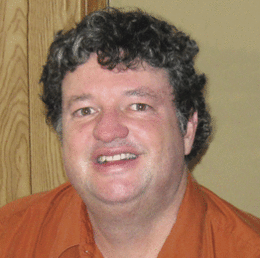
Frank Healy never forgets a face. Or his anniversary. Or, really anything for that matter.
Imagine being able to recall something about every day of your life, going back decades. It could be the weather, something that happened in the news, or perhaps a significant experience that occurred in your life. Now imagine being able to name the day of the week that corresponds with any date on the calendar—even one from centuries ago.
It sounds like something out of a science fiction movie, but for South Jersey resident Frank Healy, it’s just a fact of life. That’s because Healy is among a few dozen people in the world who possess what’s known as highly superior autobiographical memory (HSAM), or hyperthymesia, to use the more scientific name.
First identified in 2006 by scientists at the University of California Irvine’s Center for the Neurobiology of Learning & Memory, people with HSAM have the astounding ability to remember even trivial details from their distant past. This includes recalling daily activities of their life since mid-childhood with almost 100 percent accuracy, and matching up the day of the week with any given date with mind-boggling speed.
“The best part of HSAM is having a plethora of good things I can remember,” Healy, 53, says, adding that “being asked questions about things that have happened in the past and getting them right is also fun.”
The phenomenon has been profiled on CBS’ 60 Minutes and in hundreds of other media outlets. Actress Marilu Henner (Taxi) is the best-known person with the condition. Healy thought he might also have HSAM after watching a 2008 20/20 program about the topic. He responded to a query at the end of the show, and was contacted in July of that year to be part of a study taking place at UC.
“For a long time—until I was studied at the University of California—I thought having a memory like this was something I’d developed in childhood,” says Healy, now living in Cape May County and working as a licensed professional counselor. But imaging studies—a CT and an MRI—determined that, like other people with HSAM, a part of his brain’s frontal lobe is “significantly larger than most people’s. And this is something that everyone with HSAM who’s been studied seems to share,” Healy says.
The groundbreaking study, published in the July 2012 issue of Neurobiology of Learning & Memory, offered the first scientific findings about nearly a dozen people with this uncanny ability, Healy among them. All of them, it was determined, had variations in nine structures of their brains compared to those of control subjects—including more robust white matter linking the middle and front parts. Most of the differences were in areas known to be linked to autobiographical memory.
Healy believes his phenomenal memory kicked into overdrive on Feb. 28, 1966, when, as a 5-year-old, he was bedridden with chicken pox. Because he was too ill to play with toys, Healy began figuring out a few things with a calendar that an uncle had given him that Christmas.
“I just started looking at the calendar, and filling in each block on it with what would be on prime time TV each night,” he recalls. Before long, young Frank—the eldest of three kids—had figured out one show of every night of the week for the entire year. From there, he began being able to match up days of the week with dates from the past, and the future. With little effort, he soon memorized the entire calendar from the years 1752 to 2999. Meaning if you ask Healy any date in that range, he can tell you the day or the week it occurred, or will occur.
“I talked about what I was doing with my parents, but not at school with other kids,” Healy says. “From then on I would make mental events about what was happening each day. That’s how it started, and quickly became an obsession.”
And Healy’s instantaneous recall is, as I soon experience, astounding to behold. Curious about how easy it is for Healy to match up the day of a week with a specific date, I toss out three in a row: Dec. 27, 1955—“That was a Tuesday,” he immediately responds. Feb. 11, 1958? Also a Tuesday, Healy says. How about Jan. 16, 1962? Again, a Tuesday, he immediately responds. (Being that these are the birthdates of two of my brothers and myself—and knowing that all of of us were born on a Tuesday—I know that Healy is absolutely correct).
Is it hard to pull up those days of the week that quickly?
“No,” he says simply. “I just see the calendar in my mind’s eye and there it is.”
Unlike what many people have heard about those with HSAM, Healy says he doesn’t “recall everything I ate every day since this began, or what I wore—only if it was good food or a special occasion to dress,” Healy explains. He realizes that trying to explain how his memory works to a “regular” person isn’t easy, but says that part of it has to do with visual images in his mind and word association. But the ins-and-outs of it are far less simple to understand, as researchers continue to study the mechanisms behind HSAM.
Having HSAM—and all the memories that come with it—has been a double-edged sword for Healy. The fun part, he says, is to have a skill so rare: “People are fascinated by it, and from the time I was a teenager, I felt I’d always have that as a buffer—something I was really good at.” But being able to remember life experiences in such vivid detail holds true for bad memories as well as the good ones, so “it was a mixed bag for many years,” as he puts it.
Healy’s work as a master’s level professional counselor has helped him learn to “let go of the bad feelings” that accompany unhappy memories, something he says he encourages not only his clients to do, but that he’s written about in Heal Your Memories, Change Your Life, the third self-published book he’s written in the past few years.
“I decided to write books because I wanted to do something with my memory to contribute to society,” Healy says. “I’d like to be able to help people not only improve their memory, but also learn that they can overcome painful memories.”
Some of Healy’s happiest memories, he says, have come in recent years. Like May 28, 2006—a Sunday, he notes—the date he met his future wife, Janet, who “helps ground me when I get too much into dates; she’s very practical and we’re well-suited for one another.”
Then there’s July 13, 2011, when Healy first had a face-to-face meeting with Annapolis resident Sean Conlon, another person with HSAM who was part of the UC research study. “That was the first time I’d had the opportunity to just talk to someone else with this same type of memory,” Healy recalls. “It was incredible to hang out with someone who can do what I can do ... to see what it’s like to ask them the kinds of things I get asked.” And in August of 2013, Healy was invited to meet Marilu Henner, who was performing at the Bucks County Playhouse. “I jumped at the opportunity,” he says. “She was very nice; very dynamic.” And, he notes, Henner also underwent memory testing at the University of California, helping bring HSAM into the limelight.
While Healy acknowledges that his memory is far beyond the average person’s, he firmly believes that all people can learn to retrieve memories with greater ease through mental exercises and discipline. “I think the field of memory research is just opening up, and the whole HSAM thing has played a large part in that,” Healy says. “I’m excited to be part of what is being discovered.”
Published (and copyrighted) in South Jersey Magazine, Volume 11, Issue 1 April, 2014).
For more info on South Jersey Magazine, click here.
To subscribe to South Jersey Magazine, click here.
To advertise in South Jersey Magazine, click here.












